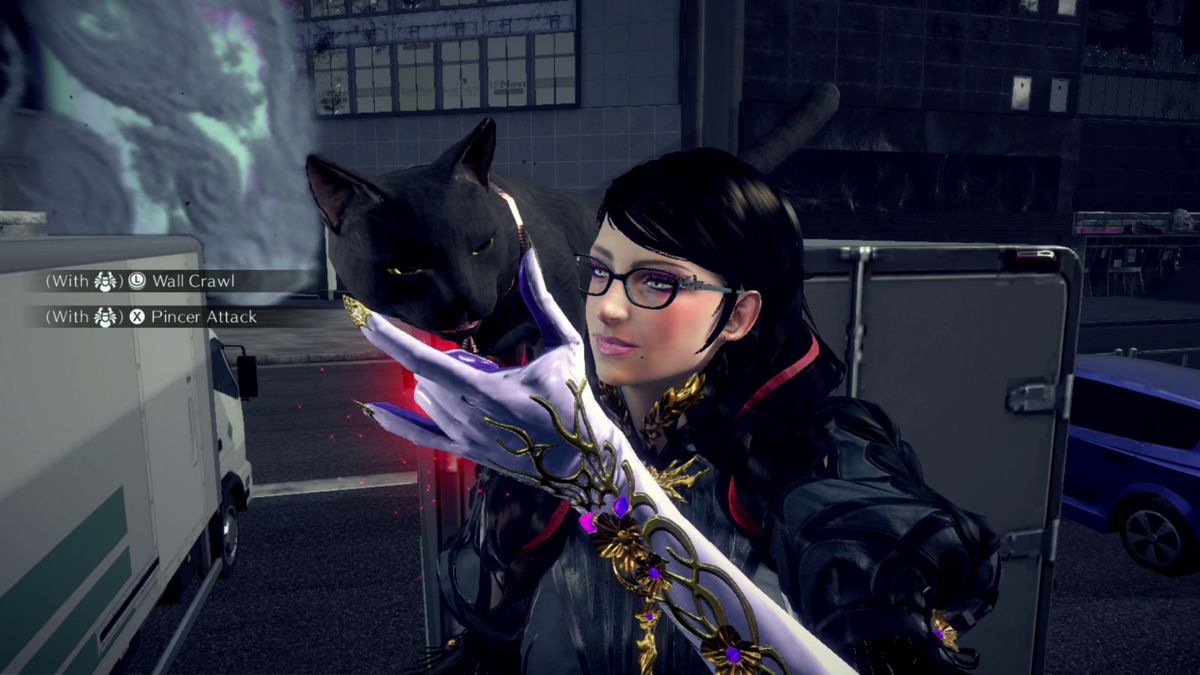12DOVE Verdict
When the witch takes charge, this demonic fighter is better than ever. After eight long years, PlatinumGames has delivered a sequel which successfully celebrates the series, although it does have problems with pacing and a split-focus.
Pros
- +
Combat really sings
- +
Smart narrative frame
- +
Solid performance on Switch
Cons
- -
Mission pacing is uneven
- -
Suffers when focus shifts away from Bayonetta
Why you can trust 12DOVE
You can't rush magic. Even so, eight years is a long time to wait for a sequel, especially one that's been teased almost the entire time. But loading up Bayonetta 3 on Switch, it's like a spell washes over me and barely any time has passed at all. Longtime series fans should feel relieved – although as ever when you deal with the dark arts, it can come with a price.
Switch owners will breathe a sigh of relief at Bayonetta 3's performance. The gunslinging witch's agile combat feels incredibly slick on the system. And while there's the odd hiccup, they were rare, which feels especially impressive given how extra all the additions to the demon-infused fighting are. Concessions have been made graphically – which is particularly noticeable in a few specific, busy sequences – but it feels in-line with the recent Bayonetta Switch ports, and boasts a visual direction that's captivating.
Bayonetta 3 really is a feast for the senses, thanks in part to a narrative conceit that's allowed developer PlatinumGames to really go wild. When a strange threat attacks Earth that's neither angel nor demon, Bayonetta must step up to save not only her world but as many as possible. Known as Homunculi, these baddies put the entire multiverse in peril, which means the Switch's witch must hop through dimensions to kick their glowing green butts.
Intergalactic planetary
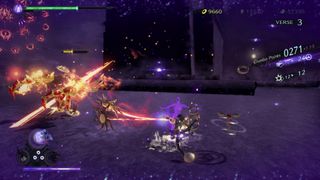
One complaint I'd always had about the Bayonetta games was that the environments you fought through could feel samey. Bayonetta 3's narrative framing is a great way to solve this particular problem, with multiple worlds beyond her own available to explore (in linear, mission-based fashion as usual). These range from a Tokyo in the midst of an attack from giant Homunculi monsters, to sandy Egyptian ruins, and even an Ancient China-themed one chock full of lava. Just as there are multiple worlds, there are multiple Bayonettas too. Despite this only being the third game, it manages to feel like a long-time series celebration that works in much the same way as something like Into the Spiderverse.
Recurring characters also return, including Jeanne who now has her own mandatory side-scrolling stealth missions. An odd choice for sure, though they're nevertheless arcadey enough to be inoffensive. Still, these contain more than a few annoying sequences, some of which remind me of the first game's worse moments as they set you back a good few minutes. For a side-activity they're fun enough, but having to play them gets in the way of Bayonetta 3's best bits – the combat. Like a spell with a bad rune, it's a flaw that comes up multiple times to just slightly knock Bayonetta's otherwise impeccable vibes off-kilter.
At its core, Bayonetta 3 is a terrific twist on the character-action genre games that came before it. After all, the series shares a director with the first Devil May Cry in Hideki Kamiya. For all their similarities – individually ranked fights and missions, two-button attack combos, buying core upgrades with an earnable currency – Bayonetta has key differences. Namely in how slick it all is.
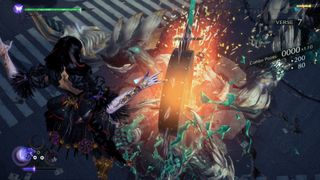
"Bayonetta 3 feels like a series celebration that works in much the same way as something like Into the Spiderverse"
Dodge just before an enemy attack and she'll activate Witch Time to temporarily slow enemies, meaning you feel like you're running circles around them. The huge combo menu is just as empowering, with almost any combination of moves ending in a different finishing 'wicked weave' move. It can feel wonderfully expressive, and Bayonetta 3 knows to keep this intact. But despite this heady brew, not everything in the cauldron compliments it.
Missions, for example, feel longer than ever. The actual runtime might not be all that different to earlier games, but it's in how they're paced that problems arise. Some levels have quite large open areas that act almost like hubs for little collectible puzzles. Traversal isn't that much of an issue, thanks to the Demon Masquerade that allows Bayonetta to fuse with whichever demon is powering her equipped weapon, granting some zippy movement powers (though they don't make the odd platforming challenges any better to deal with). But it's an odd-pace killer that doesn't feel particularly fun.
It's also rare for a mission to not have a section that's annoying to replay, whether that's a platforming challenge or slower-paced puzzle. While there are checkpoints when replaying missions, this feels like an imperfect solution for a genre where part of the appeal has always been hopping back in to blast through sequences of fights again. We're living in a post-Devil May Cry 5 world now, where almost every level there is a blast to whirl up and battle through, and doing so here often left me groaning about having to actually reach the fun bits.
Notorious DEMON
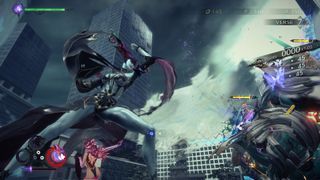
You'd be forgiven for thinking that the Demon Slaves, a new technique that has featured prominently in pre-release material, would fall into the groan-worthy category. Surely, these gigantic, lumbering beasts would slow down fights, right? They do, but in a way that still manages to compliment Bayonetta's flips, slides, and button-hold gun blasts surprisingly well. Due to the Homunculi not being angels, Bayonetta finds herself having more direct control over her contracted cadre of ferocious fiends, using dance-magic to root in place and summon them onto the battlefield. Largely, they control as she does, with their own skill trees and unique moves. Two attacks can also be cued up at once, meaning you can rely on their slightly slower movements to give you enough time to slap foes between managing their next moves. Two rhythms become one.
You can equip three demons to swap between on the d-pad, and they all have some wildly different uses. While your starting roster of Gomorrah and Madama Butterfly are quite basic, they quickly get more advanced, adding unique flourishes to how you think about the battlefield. The flying Malphas can deliver tornado-like gusts, the toady Baal can bank a sequence of four operatic melodies to rain down acid that hits all enemies, and the Wartrain Gouon slows down time while you draw ethereal train tracks that mark points for it to attack – almost like a nod towards The Wonderful 101's love of Wii U drawing mechanics.
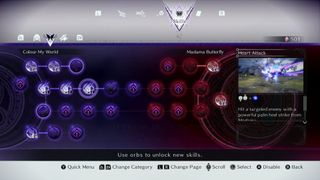
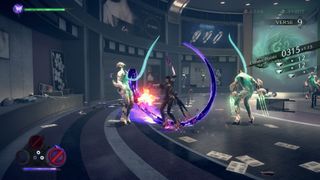
One shared skill is a boosting gap-closer attack that allows Bayonetta to own these bigger combat spaces (owing in part to her own larger Demon Slaves and the big Homunculi that appear in most battles to match them). But other Demon Masquerade skills are much more unique, to match the inventive weapons, like a part-spear, part-microphone that has Bayonetta belting out buffs and large-area damage, or a massive chainsaw that can turn her into a little charging train version of herself.
When it comes to Bayonetta's demon powered weapons themselves, there's a bit less creativity at first blush. No longer can you equip different weapons to her hands and feet. Each of the two gear sets you can hot-swap between feature only one unified weapon, but it feels fair enough in practice, especially with how they interact with the Demon Slave system. They still have built-out combo trees, but can feel more manageable to learn as a result, and the way Demon Masquerade moves are peppered in means there's plenty to learn.
Having fun with bizarre weapons is where Bayonetta 3 really sings. Still, the larger-than-life demons and Homunculi can sometimes get in the way of that. They don't quite match up to the first two games' angels, and there's a bit too much variation in their attack tells, both visually and audibly, that it can feel messy to respond to in the midst of everything else going on. Angels appear in bonus fights that you can discover, and something about battling them still clicks better when it comes to dodging and weaving at just the right time.
Violas are blue
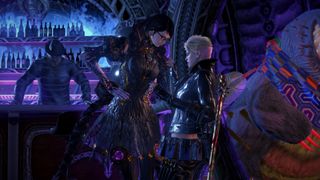
It's not just Bayonetta you play as in fights here, as newcomer Viola also gets her own chapters. Acting as a sort of guide – she's from another dimension herself – she's also something of an antithesis to Bayonetta, arriving with more of a pop-punk aesthetic. The same can be said for how she fights. With her demon sword Mabu-Dachi at her side, Viola's combos can end in charge attacks if you hold-down the attack button, combining swipes with hurls of the weapon or well-aimed darts. She can also summon a Demon Slave, but instead of her being rooted to the spot, it's the grinning, patchwork cat Cheshire who becomes leashed to wherever the demon sword lands, leaving Viola still able to run around and fight with her fists.
Perhaps the biggest difference is how Viola uses Witch Time. While she can still dodge, it won't help her fight back so easily, and instead you have to tap R at the right time to deflect a strike. As with Bayonetta, how well-timed this is alters the amount of slow-down you get, which can feel a bit punishing for Viola given that parrying is harder to pull-off than dodging, and she's a slower-paced fighter to begin with.
And considering some of the enemies she ends up fighting – many of the Homunculi are much friendlier to dodge than lock steel with, leaving it hard to get into Viola's combat rhythm as a result – especially considering she has far less missions than Bayonetta. Additionally, going from tapping ZR to activate Witch Time to R is confusing for your muscle memory, and can mean when you go from one character to the other you can feel all thumbs for a few minutes.
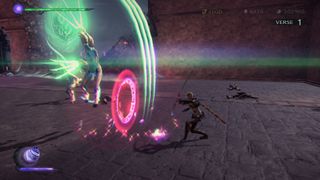
"Having fun with bizarre weapons is where Bayonetta 3 really sings"
The way this parry is implemented is a bit odd, as Bayonetta already has a parry system with the optional accessory, the Moon Of Mahaa-Kalaa, where you can counterattack and activate Witch Time by pressing the left-stick in the direction of the incoming attack. It's riskier to pull off, but the accessory is still in Bayonetta 3, and felt just as viable to use with Viola that I ended up just doing that for her final missions. While Viola's combat provides some welcome twists, Bayonetta's highly mobile combat ultimately ends up being more fun.
It's a good thing that Bayonetta, as always, is the star. The witch warrior is still a joy to both watch and play, though while Jennifer Hale puts in a good performance as Bayonetta it's disappointing to see Hellena Taylor recast in the role. For Bayonetta 3's celebratory narrative, it stings to not have the voice that took us this far there to celebrate with the fans.
When taking charge of the action, Bayonetta is more fun to rip and tear with here than ever before, with some smart evolutions in how her role as a summoner can add to her combat without taking anything meaningful away. But some of the same issues that plagued its predecessors are just as present here as well, if not more-so – just get out of Bayonetta's way, and let her do what she does best (which might not be very nice, but sure can be hella fun).
Bayonetta 3 was reviewed on Nintendo Switch OLED, with a code provided by the publisher.
More info
| Genre | Action |

Games Editor Oscar Taylor-Kent brings his Official PlayStation Magazine and PLAY knowledge to continue to revel in all things capital 'G' games. A noted PS Vita apologist, he's always got his fingers on many buttons, having also written for Edge, PC Gamer, SFX, Official Xbox Magazine, Kotaku, Waypoint, GamesMaster, PCGamesN, and Xbox, to name a few.
When not knee deep in character action games, he loves to get lost in an epic story across RPGs and visual novels. Recent favourites? Elden Ring: Shadow Of The Erdtree, 1000xResist, and Metaphor: ReFantazio! Rarely focused entirely on the new, the call to return to retro is constant, whether that's a quick evening speed through Sonic 3 & Knuckles or yet another Jakathon through Naughty Dog's PS2 masterpieces.
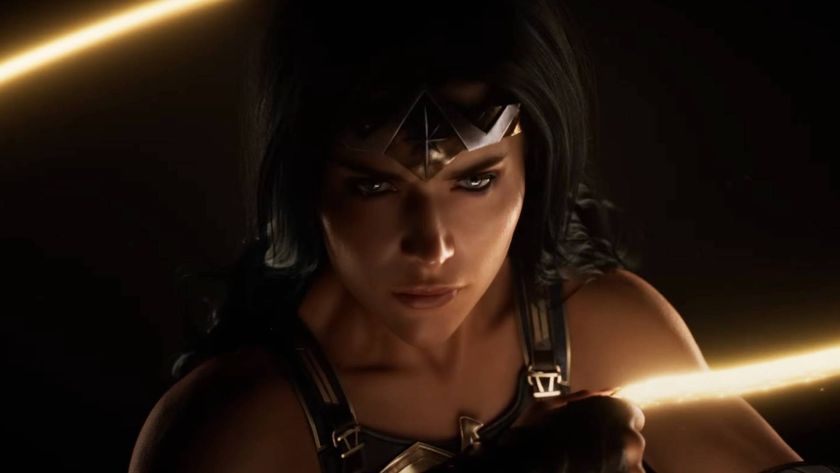
3 years since reveal, open-world Wonder Woman game from Middle-earth: Shadow of Mordor devs reportedly $100 million in the hole and struggling with tech and leadership
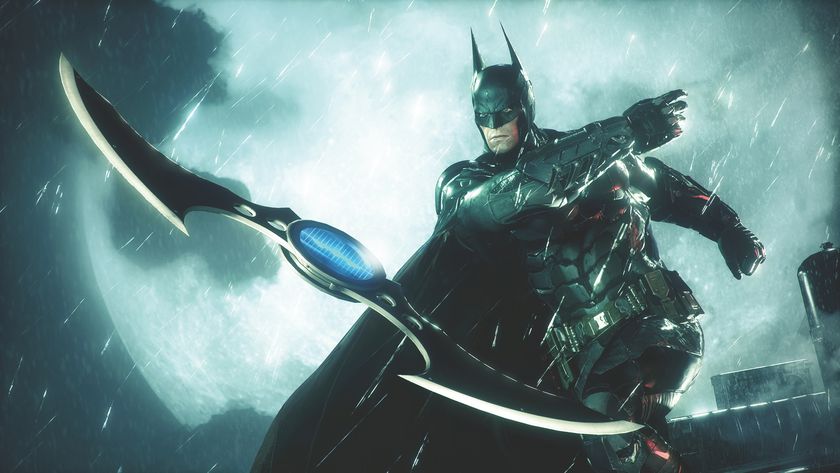
After Suicide Squad's $200 million flop, Rocksteady's reportedly back to working on the Batman games that made it a household name
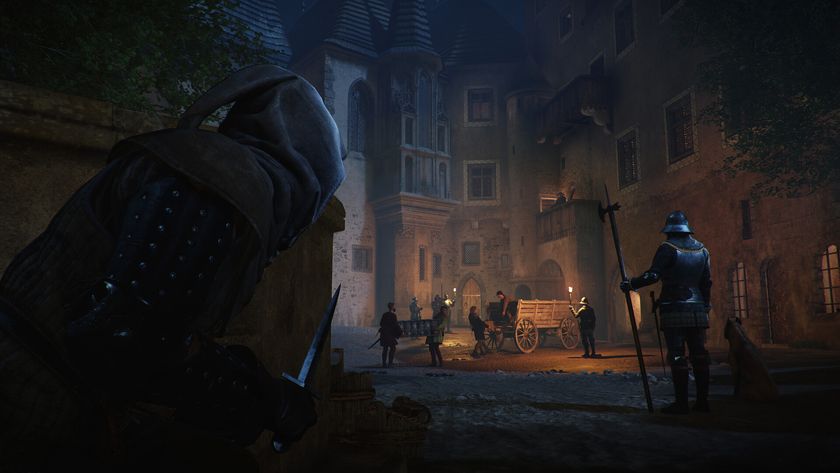
I underestimated Kingdom Come: Deliverance 2 and now I've got to find 2,000 groschen or live as a criminal forever – all because of a stupid lute
